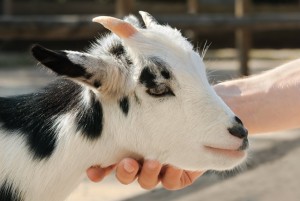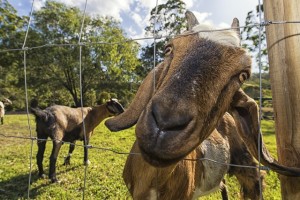Goat Diseases
Caseous Lymphadenitis in Goats
Also known as Corynebacterium pseudotuberculosis, CLA, CL, Lumpy neck, Lymphadenitis and Visceral Lymphadenitis
Caseous lymphadenitis infections occur in two forms, external and internal (often referred to as visceral).
External caseous lymphadenitis
CL infections usually result in external pus-filled abscesses ranging in size from millimetres to centimetres, in the lymph nodes in the head and neck, but the lymph nodes and subcutaneous tissue of the limbs and torso can also be affected (Nagel-Alne et al., 2015).
Wool or hair over the abscess is often lost, then it ruptures releasing huge numbers of bacteria (about 1-5 million per gram) onto the skin and hair/fleece resulting in the subsequent contamination of the immediate environment. (Fontaine and Baird, 2008).
Internal caseous lymphadenitis
CL can also cause internal (often called visceral) abscesses. They form in the internal lymph nodes and the lungs, although other tissues can be affected, including the liver, kidneys or mammary glands, and less frequently the heart, brain, spinal cord, testes, uterus and joints (Valli and Parry, 1993). If an abscess in the mammary gland bursts, the pus can potentially infect the milk (Harwood, 2006). If the herd is completely naïve to infection, the visceral form can be common and mortality can be high. However in previously exposed herds visceral abscesses are rare.
Clinical signs which accompany visceral CL infection include progressive weight loss, respiratory disorders and a swollen gut (Oreiby, 2015).
Transmission of caseous lymphadenitis
Until the external abscess bursts, goats are not too infections, however the main mode of transmission of C. pseudotuberculosis is by direct contact animal-to-animal from bacteria excreted from ruptured abscesses.. Caseous lymphadenitis can also be spread indirectly from pen fixtures and feed troughs. It is thought that bacteria invade through minor wounds and abrasions and travel via the lymphatic system to the nearest internal lymph node which then becomes infected.
Based on current knowledge. CL causes mastitis only if the abscesses are present in the mammary glad.
Caseous lymphadenitis and shearing
There is evidence a major risk factor for spreading CL is shearing (Binns et al., 2002; Serikawa et al., 1993). C. pseudotuberculosis can be transmitted on shearing equipment, clothing and mobile handling equipment. Wounds that arise are likely sources of entry for C. pseudotuberculosis. The use of shearing contractors (as opposed to doing it yourself) has been identified as a an additional risk factor in the spread of CL in the sheep sector (Binns et al., 2002).
This will be the same in the goat sector so farms who commercially rear goats for fibre should take extra precautions to ensure that shearing hygiene is paramount. Additionally, there is research to suggest that spraying iodine tincture on shearing wounds is effective in protecting stock from CL infection (Serikawa et al., 1994).
Control and Prevention of Caseous Lymphadenitis in Goats

Before purchasing stock, check them for swollen glands as this is a key sign for caseous lymphadenitis. However, goats which appear healthy may also be harbouring disease so quarantine is still very important.
The best means of prevention is keeping the infection off the farm. A closed herd is the safest and easiest way to keep the disease off the farm as any purchased goat is a potential risk. If you have to buy replacements avoid buying goats with swollen glands. Seemingly healthy goats may still be incubating the disease so a robust quarantine procedure is also important. It is recommended that new stock is kept away from the main herd for at least 2 months and observed and handled regularly to look for signs of swollen glands (Harwood, 2006).
C. pseudotuberculosis infection can become endemic in a herd and is difficult to eradicate because of its poor response to treatment, its contagiousness and ability to persist in the environment, and the limitations in detecting sub-clinically infected animals (Al-Gaabary et al., 2009).
C. pseudotuberculosis can also be transmitted on clothing and equipment such as weighing and handling crates so make sure these are thoroughly cleaned and disinfected before and after use (Harwood, 2006).
Eradiation infected herds involved culling/segregation of infected animals. This costly approach is only really practical in herds that do not have a high incidence of disease (Fontaine and Baird, 2008).
Diagnosis of caseous lymphadenitis in goats
If several animals have external abscesses this is highly suggestive of CL but confirmation of infection can be made by bacterial culture and identification from a swab of a burst abscess. It possible to isolate the organism from lesions of all ages, although the number of viable bacterial in old abscesses may be low (Al-Gaabary et al., 2009).
Vaccinating against caseous lymphadenitis in goats
Immunisation has been shown to reduce the spread of infection, leading to a gradual decline in prevalence, however none of the currently licences CL vaccines offers complete protection against C. pseudotuberculosis (Fontaine and Baird, 2008; Paton et al., 2003). For immunisation with inactivated vaccines, two administrations, with a three-week interval between them, are necessary; then, annual repeats of the administration are required for optimised protection of vaccinated animals (Lacasta et al., 2015; Paton et al., 2003).
Treating Caseous Lymphadenitis
There is no reliable treatment available to treat CL infections.
Some of the literature suggests lancing abscesses but this leads to huge amounts of bacteria being excreted from the wound, hence a lot of environmental contamination. Lancing potentially has a role for treating individual animals whose abscess is bothering the animal given its size and location, but should not be used as a general treatment means.
Good Practice Based on Current Knowledge

Maintain a closed goat herd is the best way to protect your animals from diseases such as caseous lymphadenitis.
Management measures should aim at preventing the disease from entering the flock; for example, maintaining closed flocks, prolonged quarantine periods for bought-in stock and proper hygiene measures when handling stock.
In caseous lymphadenitis-free flocks:
- Isolate and observe any purchased stock, and regularly examine for swellings and discharging abscesses before mixing with the existing flock
- Good hygiene should be maintained during kidding, docking and castration
If caseous lymphadenitis is confirmed:
- Isolate and destroy infected animals
- The flock should be regularly checked for the occurrence of new cases
- Any shared (including handling or shearing) equipment should be thoroughly cleaned and disinfected between animals
- Consult a vet regarding a vaccination strategy


 American English
American English


Comments are closed.